目次
- INTRO
- MODERN SLOVAK GLASS
- GLASS &ART
- STUDIO OF GLASS -ACADEMY OF FINE ARTS AND DESIGN IN BRATISLAVA-
- GLASS & DESIGN
- ACADEMY OF FINE ARTS AND DESIGN IN BRATISLAVA
- SLOVAK GLASS FACTORIES
- ALEKSANDRA STENCEL & PATRIK ILLO
- ALEKSANDRA STENCEL x GLASS DESIGN
- ALEKSANDRA STENCEL x GLASS ART
- PATRIK ILLO x GLASS DESIGN
- PATRIK ILLO x GLASS ART
- ILLOLA
- Q&A
INTRO
This will be the sixth instalment of “Art and Society,” a project in which specialists in various arts teach us about culture and history through art.
This time, two guest-lecturers will teach us about art and design.
The first half of the program will be on “Contemporary Glass and Art & Design in Slovakia,” taught by PATRIK ILLO, a professor at the Department of Glass Design at the ACADEMY OF FINE ARTS AND DESIGN IN BRATISLAVA.
In the second half, AlLEKSANDRA STENCEL from Poland will talk about art and design, introducing their own works and that of their artists group, ILLOLA.
Both of you had worked as product designers at RONA, the biggest glassware studio in Slovakia, while also contributing to the art department of Studio Glass. Thus, in Europe, “artists, designers or craftsmen”, who work with “glass” do not have much of a boundary between “art, design, craft”. This may be a remnant of a time before the modern division of labor, when artists who were “painters and designers” or “inventors and craftsmen” were the norm. Today, we are going to learn a lot about these things.

MODERN SLOVAK GLASS
Let me now introduce the general flow of contemporary glass in Slovakia and the important artists who have created its history.
After the Second World War, the Czech Republic and Slovakia became independent from each other, and after 1980 they became Czechoslovakia again. The development of Slovak glass is in proportion to that of Czech art and design glass. In this issue, we will introduce the development of contemporary glass, focusing mainly on Slovak artists from the middle of the 20th century.

We can roughly expand on the figure above. On the art side, a particularly important figure is VÁCLAV CIGLER (1929-), a Czechoslovakian who became the first professor in the glass design department of the ACADEMY OF FINE ARTS AND DESIGN IN BRATISLAVA, which was founded in 1965.
On the design side, an important figure in table glass design (wine glasses, cups, etc.) is KAROL HOLOŠKO (1912-1978), who was a studio craftsman and designer at the LR CRYSTAL glass factory design studio from 1950.
These two men went on to become very important educators and influences on both sides.
GLASS &ART
Let’s take a look at the “Glass art” artists.

First is ĽUBOMÍR BLECHA (1933-2009), a Slovak, although not a graduate of the National Art University of Bratislava. He developed the technology and technique of inserting lines into blown glass (Blown glass)

Although he was not an educator at a university institution, he was a major contributor to the development of glass and the evolution of technology in Slovakia.

VÁCLAV CIGLER (1929), the first Czechoslovakian professor of architectural glass design at the ACADEMY OF FINE ARTS AND DESIGN IN BRATISLAVA, produced many important glass artists from 1965 to 1981.


He was one of the first artists to incorporate optical (technical) glass into art glass, and in addition to sculptural works, he also created glass art jewelry and glass installations in architectural spaces.

ASKOLD ŽAČKO (1946-1997), also a professor at the Bratislava University of Arts, produced some Ziegler-style glass and some 90s modern-style pieces.

JURAJ GAVULA (1942-) is a professional sculptor who works with a variety of materials, not just glass.

Patrick himself has been greatly influenced by him.

ŠTEPÁN PAL (1944-) and ZORA PALOVÁ (1947-) are a married couple of glass artists. Zora has taught art in England, and together they make very experimental and outdoor glass works.

EVA FIŠEROVÁ (1947-) works in heavy cast glass, like an abstract sculpture in stone carving.

MARIÁN MUDROCH (1945-2019) is heavily influenced by Professor VÁCLAV CIGLER. She creates minimalistic and conceptual work.

LACO PAGÁČ (1949) was an important conceptual artist and designer and a high school teacher. His lineage of art activities included happenings, ritualistic performance art, and land art in the 80s. He was a member of the art group “P.O.P.” (LACO PAGÁČ – VIKTOR ORAVEC – MILAN PAGÁČ) and a student at the Cigler studio, where he worked with a wide variety of non-glass mediums.

Technology-intensive artist PAVOL HLOŠKA (1953-) welds perfectly polished, heterochromatic glass and also creates large glass works, such as the 2-meter piece on the right in the photo.

MILOŠ BALGAVÝ (1955-) also uses optical glass to create quiet, strong works of geometric and symmetry.
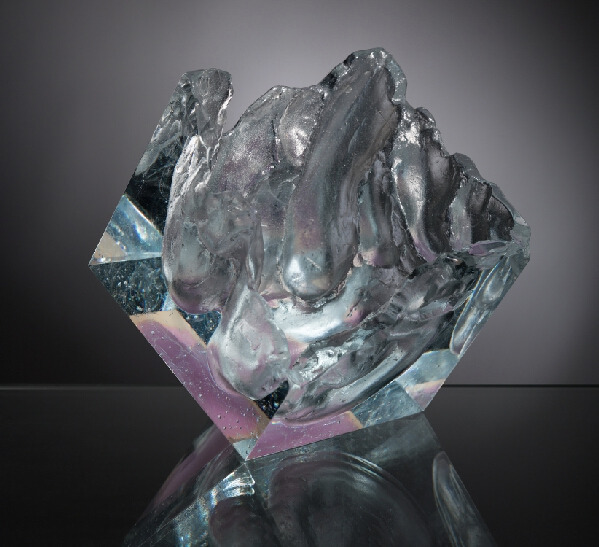
JURAJ STEINHUBEL (1958-) is a glass designer who collaborates with several glass companies and also creates his own artistic works, such as the photo below.

VLADIMÍR ZBYŇOVSKÝ (1964-), a Slovakian artist living in France, will combine glass and stone in his spectral works.

PALO MACHO (1965) is a colleague of PATRIK ILLO at the University. He creates installations with painted glass, varying the shape, color, and structure of the sheet glass.

OLIVER LEŠŠO (1972-), a college classmate of PATRIK ILLO, is a creator of unprecedented technological and technical excellence.
STUDIO OF GLASS -ACADEMY OF FINE ARTS AND DESIGN IN BRATISLAVA-
Next, we will look at the work of another generation of young artists who graduated from the Department of Glass Design at the ACADEMY OF FINE ARTS AND DESIGN IN BRATISLAVA, where PATRIK ILLO has been a professor since 2010.

It is a simple form combined with the pursuit of geometric forms by ANDREJ JANČOVIČ (1986-) and motifless glitter by PAVOL BARKÓCI.

FILIP PLAČKO, pictured left, created an electrified piece of glass and gold leaf. The conceptual installation by MARTA VJATRÁKOVÁ MATEJKOVÁ (1990-), in the middle of the photo, is very interesting, including a work made of hardened glass shavings and a large glass hanging in a church.
GLASS & DESIGN
Now, here is the second part, “Glass Design”. I will only introduce some of the important parts of Slovakia. These product glasses are mainly made in large workshops and factories.

In the past history of Slovakia there were more than 100 glass factories. However, today only two companies (including company mergers) are operating, one is “RONA GLASS FACTORY” located in LEDNICKÉ ROVNE and the other is “LR CRYSTAL FACTORY”.

The founder of LR CRYSTAL FACTORY, KAROL HOLOŠKO (1912-1978), has created a set of glassware with a cutting-edge image that is still relevant today, and which can be called the ultimate design for high functionality.
The designs of the 1960s are simple and expensive. For Czechoslovakian workshops, which had a large market outside the country, these designs are suitable for the international market.

JAROSLAV TARABA (1932-2020), a colleague at KAROL HOLOŠKO’s LR CRYSTAL FACTORY, has a similarly simple design.

He employed many of the sensibilities and techniques of punt glass, an acid-corroded and etched design.

One of the leading faces of Slovak glass, designer and glassblower Jozef Staník (1908-1986), is famous for his designs at Zlatno Glass Factory, including Zlata Zuzaana (Golden Susanne). The gold-toned decorative glasses were recommended as the official gift of Czechoslovakia and were a smash hit, selling 5 million sets in the country and neighboring countries.

VÁCLAV CIGLER (1929), the maestro who has appeared many times today, was also a designer. His full moon light, a bulb light with 100 programmable lights installed in the Slovak National Theatre, was nominated for an international design award.

ASKOLD ŽAČKO (1946-1997), he was not only an artist but also a designer. He also presented his design glass at LR CRYSTAL FACTORY.

In the art glass section, LACO PAGÁČ (1949-), a glass artist who also performed with the art group P.O.P., was a designer at LR CRYSTAL FACTORY.

His diverse talents and the distance between art and himself are exquisite.

JOZEF KOLEMBUS (1955-), on the left in the photo.
JURAJ STEINHUBEL (1958-), pictured middle right, and others, show extremely high quality design and technique.
ACADEMY OF FINE ARTS AND DESIGN IN BRATISLAVA
Let’s take a look at the designs of former students of Professor PATRIK ILLO at the Department of Glass Design at the ACADEMY OF FINE ARTS AND DESIGN IN BRATISLAVA.

PETER ĎURIŠ is mold-blown glass that cracks the outside of two layers of glass.

PATRÍCIA ŠICHMANOVÁ focuses on pedestals that support spherical vessels.
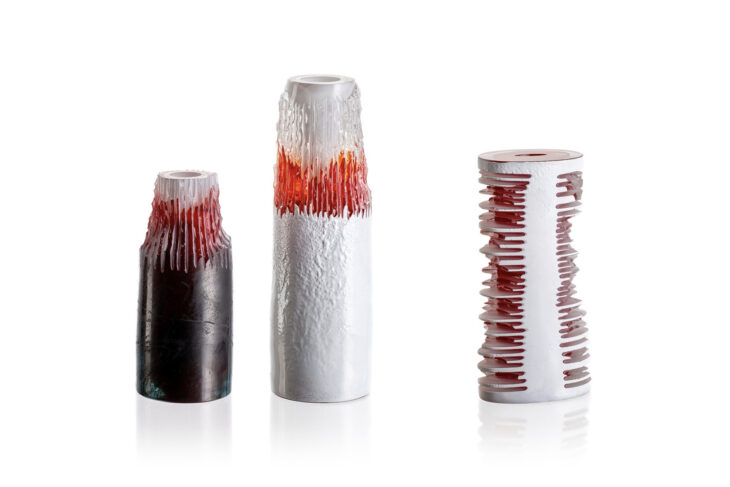
IGOR KOVÁČ uses a saw-machine for glass to show cut marks.

ZUZANA KOVÁČIKOVÁ develops heteromorphic objects by molding thin copper plates and using them as molds for blown glass.
SLOVAK GLASS FACTORIES

Let me now introduce you to the glass design factories (also called glassworks, ateliers, and studios) in Slovakia.
As previously described, there are currently two large design glass workshops in Slovakia.
R-GLASS, with its army of blue artisans in KATARÍNSKA HUTA, and RONA GLASS FACTORY, with its trademark red color in LEDNICKÉ ROVNE.

RONA combines both a manual workshop and a mass production line, with a showroom and store.

RONA also regularly hosts the RONA – INTERNATIONAL GLASS SYMPOSIUM, where artists stay for a few days to exhibit their work in the gallery and auction it, similar to the IGS in the Czech Republic.
This concludes the first part of our introduction to the art and design genres in contemporary Slovak glass from the mid-20th century to the present day.
ALEKSANDRA STENCEL & PATRIK ILLO
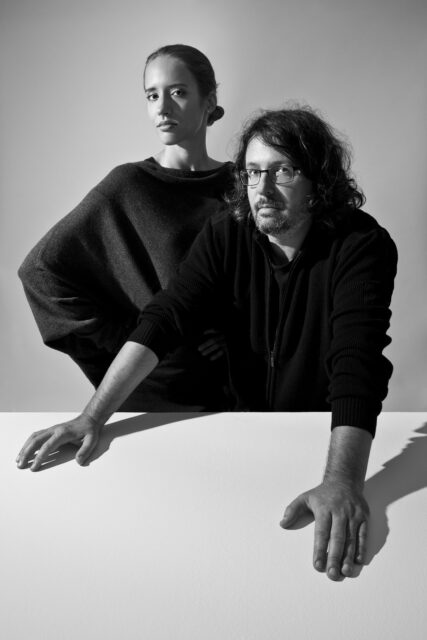
Let’s start by looking at the personal GLASS DESIGN of ALEKSANDRA STENCEL
Aleksandra is Polish, but most of her professional glass design glass has been done since she came to Slovakia. The photo shows her products when she was a designer at RONA.

The set of glass is very creative in combination, layering, and a wide variety of designs. The design is composed by researching not only the purpose of the product, but also the patterns of various countries overseas. The concept, design and technique, as well as the physical photography and presentation are very sophisticated.

ALEKSANDRA STENCEL x GLASS DESIGN

In the works of the collection at the glass company in Wrześniak, Poland, she presented the mirror burning technique.
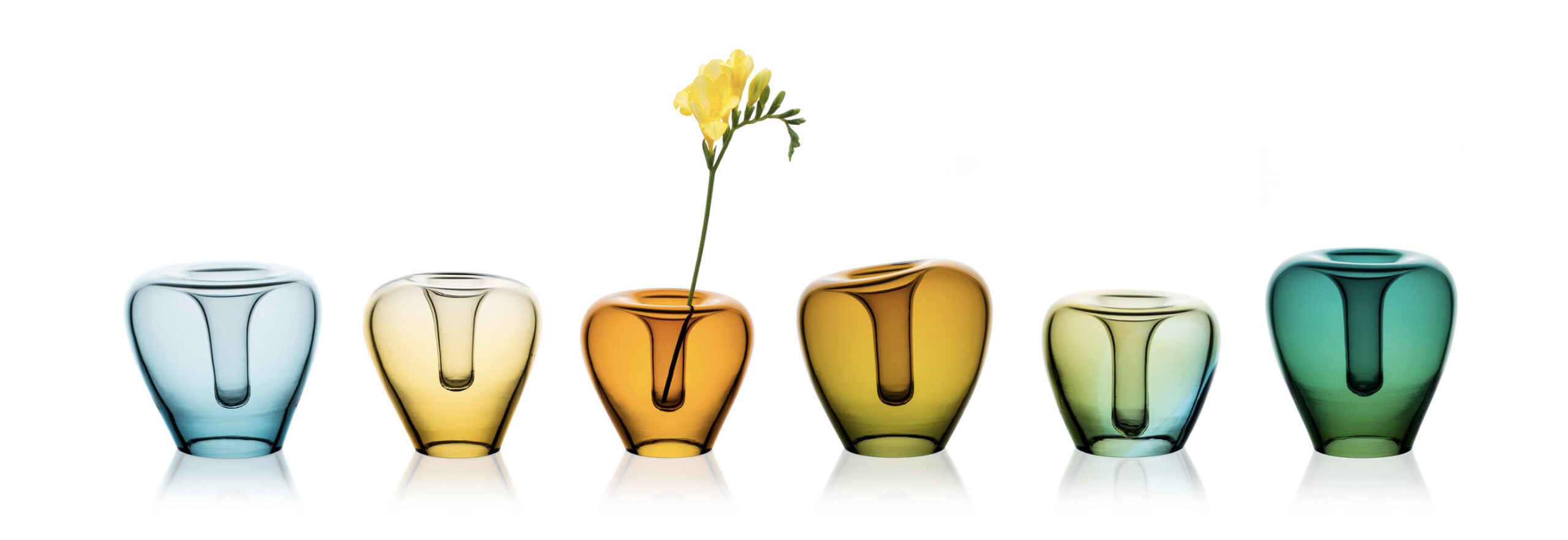
Outside of Slovakia and Poland, for example, she has also produced works at the Czech studio, Egermann. Incidentally, Egermann and many other large glassworks have been forced to close their doors in recent years due to demand, rising raw material prices, and problems with staffing.

Alexandra’s sensitivity to both aesthetic objects and functionality is evident in all of her glass.

In one of his latest works, named “Tap Dancer,” she has done a delicate and fashionable job with a nifty arrangement at the bottom. Copyright is important for such a great idea, but the registration, expense, and various issues involved in copyright are very complicated and difficult.

It seems to her that works that are designed with a playful concept of the function and definition of a “cup” for holding liquids will still expand the possibilities of cups.

ALEKSANDRA STENCEL x GLASS ART
Let us now move on to the artistic productions and concepts.
The picture above was created for the RONA – INTERNATIONAL GLASS SYMPOSIUM.
She finds her artistry in emotional portraits of himself.

She pursues the technique of molding her own face and expressing it in glass.
The photo on the right was produced at the International Glass Symposium Nový Bor (IGS) in Nový Bor, Czech Republic. Enamel, a traditional Czech decorative material baked at high temperature, is used for the decorative part of the glass surface.

Using her own portraits, she was inspired by Millet’s painting of Ophelia in Shakespeare’s play Hamlet.

PATRIK ILLO x GLASS DESIGN
We will now look at Patrick’s design glass work.
We will start with his produced work at the glass company RONA.
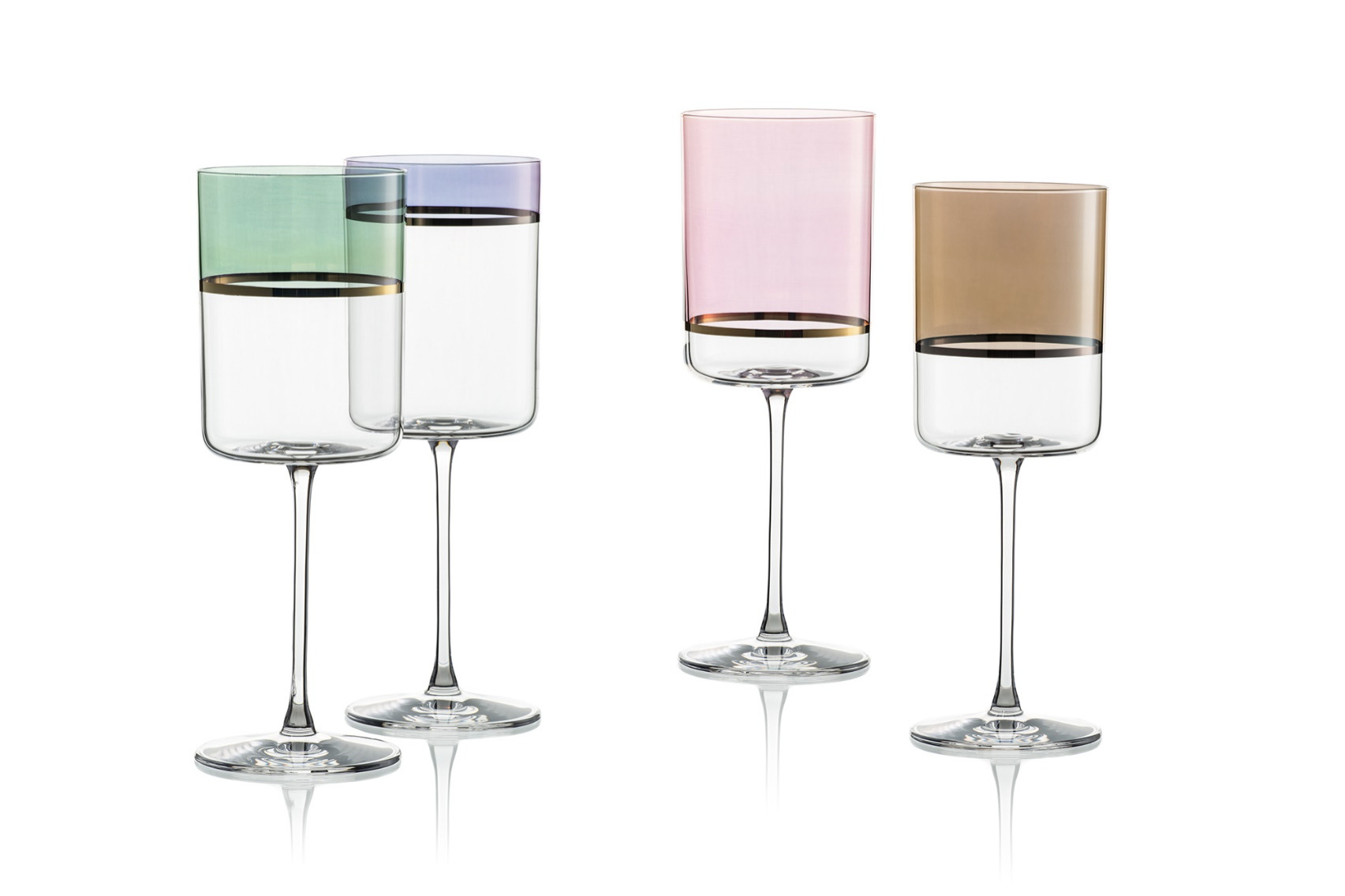
This one is hand-colored.

This is a hand work, a wine decanter. The different curves and designs allow for different uses. I think the combination of glass and organic nature is a feature that allows handwork and creates interest.

The Soap Bubble Glasses on the left of the photo feature organic recesses and hand-applied metalwork on the surface of the glass, giving it a bubbly sheen and reflection. An interesting feature of the vase on the right of the photo is that the center of the vase is a block of glass, and flowers are arranged in the two bag-like spaces on the outside.
The most interesting aspect of contemporary glass design is how it always deviates from preconceived notions of “glass” and “vessels” to create something new, playful, and design-oriented.

The combination of the raw state of the glass before it is refined, and refined cut-glass, the cup has a combination of the evolution of the glass.

This is a slightly unusual vase with an image of a woman, created at the Czech glass studio ŠTĚPÁNEK.

PATRIK ILLO x GLASS ART
Let’s take a look at Patrick’s artistic glass works.

Many of the forms and techniques are in pursuit of the possibilities and limits of what glass can do. Patrick exhibits his works in many countries around the world, but handling glass is so difficult and delicate that some pieces break during transportation and exhibition.

New discoveries are made through various challenges, such as glass installations and conceptual works that do not even use glass.

ILLOLA
Finally, I would like to introduce the creation of their joint brand ILLOLA. The name comes from Patrick’s last name ILLO and Alexandra’s short name in Poland, OLA. Thinking and creating together creates a chemical reaction that generates ideas and concepts that would not come to mind alone.

This one is called the “Secret Garden Project” and was created using traditional decorative techniques and perspectives, and the relationship between humans and nature as the starting point. The decoration is seen as a metaphor for nature and humans, and depicts a mysterious and humorous encounter between humans and insects and other creatures.

Biodiversity is also a keyword, projecting an image of the good and bad relationships between humans and plants and animals. A classic pantograph decorating technique is used. The image image jumps out of two dimensions and is processed as if a three-dimensional glass vase has been bitten off by an insect.

This is an exhibition of more than 1,000 drawings and ideas extracted from the drawings, which were made into three-dimensional glass objects.
“As we continued to work with our hands day after day, we were sometimes discouraged by the results of the drawings, and sometimes we discovered something. However, in the end, we are always moved and surprised, which is our important motivation. Finally, we held a solo exhibition to show all of our work. Please take a look at this video to see some of the works.”
I hope you enjoyed and learned something interesting for you.

Q&A
Q&A
Q1: I imagine that working together as team is interesting, but at the same time it must be very difficult.
A1: Yes, we argue a lot (Laughs). But I think of myself as a different person at ILLOLA, and that serves as a receptacle for mutual tolerance. However, we simplify the ideas that we both don’t agree on, and refine the ideas that remain after scraping them off. I believe that there is always something new happening, something fresh, creative, and important.
Q2: I assume that each of you has a different way of thinking, workflow, and market for your “design glass”, “art glass” and group activities.
A2: Yes, I have become more aware of this recently. For example, in the Secret Garden series, I work in a factory, where I develop manual work and technology, but I must always think about the consumer. We have to generate what we can or more based on what consumers like, what they are willing to pay for, what is acceptable, etc.
Q3: I think the design side of the business has a lot of company marketing and suggestions for selling. In contrast, it is easy to imagine that artistic work is frequently not understood or difficult to sell, but you still want to continue to do art glass?
A3: Yes, of course. For example, ILLOLA’s Secret Garden series is hardly a technology that can be mass-produced, and the price range and aesthetics are quite eccentric. However, there is meaning in that, and I think it is important to continue to do so.
Q4: There are works in which you mix non-glass materials in the production or do not use glass at all; isn’t it difficult to continue to do so in parallel?
A4: It is, but first of all, the production part of other materials may be finished by professionals in each department, which means that it is not necessary to be an expert in all departments, and concepts and ideas are important.
Q5: I think young writers yearn to do as many different things as you two do. Do you have any advice for them?
A5: Just do the work, that’s all. For example, I remember when I was a student, I wanted to do all the work myself. However, after graduation, I have taken the approach of asking other professionals to do the production. However, the skills and know-how I developed as a student are absolutely crucial when working as a designer after graduation.
Q6: Patrick, you have educated many college students and produced many artists. How do you see the situation of students becoming artists after graduation?
A6: Quite simply, it is very difficult to become an artist. There are many artists today, and it is not easy to keep going. It is important to have some money, to be lucky and happy, and to work hard.
Q7: What do you think is the future of the glass industry?
A7: I think it has to do with how AI will change the world, and in the age of AI, I personally think that art needs to be a kind of “something special and boring”. I think we need something completely new and different in art.
Q8: Finally, if I want to study at the Bratislava National University of Arts, do I have to speak Slovak?
A8: No, it is possible to take the exam and enroll in English. We encourage you to contact the student affairs office and try to study in Slovakia.


